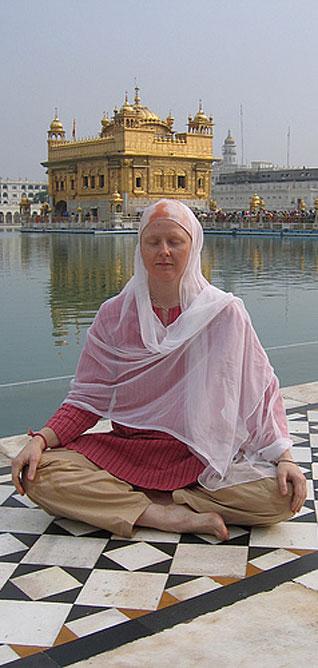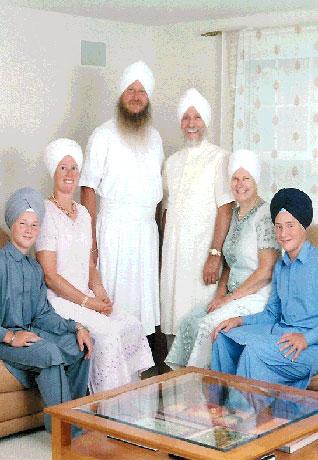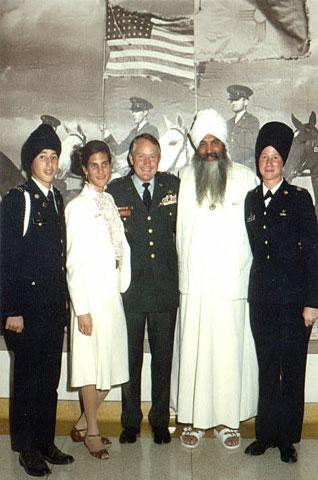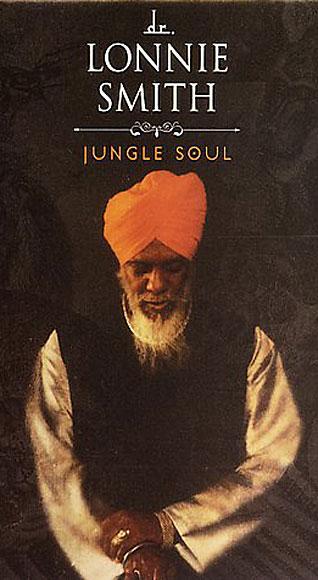
Images below: second from bottom - Singh Sahib Harbhajan Singh (2nd from right) with Sikh cadets. Third from bottom - three generations of a Sikh family. Homepage image: courtesy - Gurumustuk Singh. Thumbnail - Renowned Jazz Musician, Dr. Lonnie Smith.



People
Sikhi Crosses Racial, Ethnic Barriers
by NIDHI SHARMA
Kirpan-wearing Sikhs roaming the city of Amritsar in Punjab are a normal sight; but "western" people wearing turbans definitely are not. The strangeness lies in the fact that they are the progeny of westerners who converted to Sikhism a generation or two ago.
[The term "white" used for these converts is erroneous, because many of them are actually "black"!]
Most of them attend the Miri Piri Academy (MPA), an international boarding school in Amritsar, where the children of "western" Sikhs attend, to immerse themselves in the Sikh way of life.
And don't let the teacher's name, Mahan Atma Kaur, mislead you. She is the former Svetlana, a Russian-American national who has been teaching there for two years.
The 34-year-old teacher converted in 2004 and changed her name to Mahan Atma, which means "great soul" in Punjabi.
Why?
"It feels to me that I did not 'choose' to be a Sikh. We all are Sikhs, as 'seekers of the truth.' As soon as I felt my heart's yearning for the Guru's Word, I knew it was my path. It is my life," says Mahan Atma.
The current student body represents 13 countries and 8 languages from various countries in Asia, Europe and America.
Although Sikhism does not have missionaries around the world, more and more are converting to Sikhism in the 21st century, even though Sikhism as a faith has never actively sought converts. Today, Sikhs are to be found amongst all races and ethnicities.
Why Sikhism?
After the September 11, 2001 attacks, some people confused Sikhs with members of the Taliban because of their turbans. Research suggests there has been an increase in hate-crimes against Sikh men in America and England. Still, there has been an increase in the number who convert to Sikhism.
Why?
Gurusewak Singh Khalsa, who was born to parents of American/European descent, explains:
"Some might say Sikhism is a strict religion. At first glance this makes sense - physically, men have beards, wear turbans and kirpans, and women don't cut their hair.
"But once one sees past the physical, I have found that there is a lot more openness, freedom, and acceptance in the Sikh teachings, compared to other religions," he added.
Amrit Kaur does not look like a Punjabi in any way, but practices Sikhism. Born in Toronto, Canada, her mother was an atheist and her father was Catholic.
"I researched many religions and practiced different ones ... but nothing 'belonged' to me. It wasn't until the summer of 2004, when I first met a Sikh, that I learned about the existence of Sikhism," she writes in her blog.
We talked to Dana Singh, who is dedicated to the cause of Sikhism. Born in Latvia (former USSR), she met her Sikh husband in Ireland, and he introduced her to his culture and religion. Though she has not formally converted to Sikhism, she still considers herself a Sikh.
"Earlier, I had never heard about Sikhism and wasn't aware that this is the fifth largest religion in the world. We married in Amritsar in a traditional ceremony. It was so different from European weddings - like a fairy tale," she revealed in an interview.
Ask her why she chose to live her life as a Sikh and she replies, "I didn't convert formally, but just live and learn everyday more and more about Sikhism."
Due to the activities of Singh Sahib Harbhajan Singh ji Yogi (popularly known as Yogi Bhajan) - he taught Kundalini Yoga through his 3HO (Happy, Healthy, Holy) Organization - Sikhism has witnessed a surge of interest amongst those of American, European and African descent.
It was estimated that in 1998, these 3HO Sikhs totalled 7,800 members, and were mainly centered around Española, New Mexico and Los Angeles, California.
After the death of Yogi Bhajan, the U.S. Congress passed a bipartisan resolution honouring his life and work, thus equating his life with a select few - Dr. Martin Luther King Jr., Mother Theresa, and Pope John Paul II.
Like her teacher Yogi Bhajan, Mahan Atma Kaur, a psychology major from St. Petersburg State University in Russia, also teaches Kundalini yoga. "I decided to move to the U.S. and came in contact with Yogi Bhajan."
Ask Mahan Atma how her family reacted to her "transition" and she says that her mother was "very supportive" and said, "I don't understand what it is, but whatever it is you do, it makes you great! You are as clear and pure as crystal!"
The views on conversion from one religion to another are varied. Brij Bedi, a social activist from Amritsar, said in a telephone interview, "Be it Islam, Christianity, Hinduism or Sikhism, all religions teach the same principles of equality, non-violence, faith, selflessness and love towards humanity."
Matt Borghese, a content writer based in Florida, says that the "third world religions are catching on in the first world. Who would have thought it? That is a growing trend in the U.S. I see white guys in Sikh turbans all the time. One I saw over the weekend had a white turban and bright red beard."
Historically, the phenomenon of conversion of whites to Sikhism is centuries old.
Max Arthur Macauliffe (1841-1913), a senior British administrator who was posted to India during the British rule of Punjab, converted to Sikhism in the 1860s. As a prolific scholar and author, Macauliffe is held in high esteem among the Sikh community for his monumental history of the Sikh Religion and his partial translation into English of the Sikh Scripture, the Guru Granth Sahib.
In more recent times, well-known figures who have been attracted to the treasures of Sikhi include Vic Briggs, a 64-year-old London resident and former blues musician (The Animals). He took the name Vikram Singh Khalsa. Later, he performed kirtan in the Harmandar at the Golden Temple.
Dr. Lonnie Smith, a 67-year-old New York resident, is a jazz musician, recognized as an exceptional player of both the Hammond B3 organ and piano, also converted to Sikhism, but did not change his name.
 
[This article has been revised from the original, first published by Russia Today.]
July 17, 2009
Conversation about this article
1: Gurjender singh (Maryland, U.S.A.), July 17, 2009, 7:16 PM.
This is a very nice article. All of this is due to the efforts of Bhai Harbhajan Singh ji Yogi. He had done a wonderful job of spreading the word of Sikhi. He even opened the Miri-Piri academy in India to bring up our children in Sikhi. No other institute or organization has done as good a job. Also, not many families want to send their children away for a few years to learn about Sikhi. It is indeed a big effort and sacrifice. Our leadership has failed to promote the teachings of our Gurus outside the four walls of the gurdwaras. They need to learn from the example Yogi ji has left behind.
2: Gurmeet Singh Grewal (New Jersey, U.S.A.), July 18, 2009, 9:32 PM.
I agree with Gurjendar Singh that neither the S.G.P.C. nor the Akali Dal (Badal) has done nothing for Sikhs and Sikhism. The Akal Takht and the S.G.P.C. control the gurdwaras but nothing has been done to promote Sikhism. I called them the Uniformed Mafia who even though they wear the Panj Kakaars to look like Sikhs, they are involved in everything but the Sikh cause. The Sikhs mentioned in the article, however, are worth lauding because they live in Sikhi. They follow the teachings of the Gurus in their daily lives.
3: Raj (Canada), July 19, 2009, 12:22 AM.
Give foreign-born Sikhs kids, of Punjabi or non-Punjabi backgrounds, a few years; they'll go to India and teach Sikhi to them. BTW, let's not complain about the S.G.P.C., Akalis or Badals, just don't support them financially. I mean, when you go there next time, don't put any money in golaks and offer prashads. Apply your daswandh directly to community projects. Remember, the Guru doesn't need your money. Choke these rascals financially. We need to start a revolution within Sikh institutions.
4: Gurjender Singh (Maryland, U.S.A.), July 19, 2009, 6:33 PM.
Raj ji, you may be right. But the original base of Sikhi was on the subcontinent. Sikhs have steadily been losing their base and foundation places. Look at Buddhism: it was also born on the subcontinent, but its followers are now to be found everywhere but there!
5: Bhag Singh (Penang, Malaysia), May 11, 2010, 8:47 AM.
sikhism has now got to proceed through any language or culture as Guru Nanak taught that God is beyond language, including Punjabi. It's time now Sikhs translated all banis into their local languages. This was what our Gurus taught us, i.e, the quantum and holographic concepts of God. Do not get stuck in the Punjabi culture and language. Be a Sikh in your own western (or local) culture and language, only then will you be considered being a Gursikh of the Gurus.


